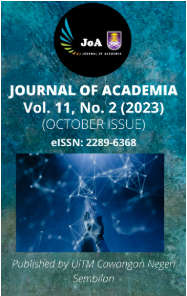EXPLORING GENETIC INFORMATION TOPICS BY USING AUGMENTED REALITY IN GAME-BASED LEARNING
Keywords:
Educational games, Augmented reality, Mobile Application, Genetic Information, CybergogyAbstract
This study focuses on the development of an augmented reality learning tool in the game-based learning for the foundation Biology I (PAA 10104) course, along with its effects on student performance as well as their attitude towards the software. The student has the difficulty to learn and take more time to understand the subject. The aim of this study is to explore the impact of the tool on students’ cognitive performance and to gain an understanding of the various mechanisms and pathways of biological information expression. The results of the research will be used to determine the efficacy of the augmented reality software in teaching the subject matter. In this study, 85 students from UniSZA Science and Medicine Foundation Centre were involved. Augmented Reality interfaces are entirely based on the target user by applying a standard graphic user interface (GUI) in the virtual world. The students were instructed in answering the Nucleo-Beads boardgame’s survey and questionnaires. From the questionnaires, the feedback from student’s perceptions were analysed. The findings demonstrate that students' active involvement in hands-on activities has a particularly positive impact on their perception of enjoyment, which increases their motivation to learn. As a result, learning materials are seamlessly integrated into the environment around students in these augmented reality environments. Future research could investigate the impact by running experiments involving two or more student groups. Through game-based learning, this would give more insightful information on how to use augmented reality mobile applications.
References
Abdul Jabbar, A. I. A., & Felicia, P. (2015). Gameplay engagement and learning in game based learning. Review
of Educational Research, 85, 740–779.
Cascales-Martínez, A., Martínez-Segura, M. J., Perez-Lopez, D., & Contero, M. (2017). Using an augmented reality enhanced tabletop system to promote learning of mathematics: A case study with students with special educational needs. Eurasia Journal of Mathematics, Science and Technology Education, 13(2), 355–380.
Chang, K.-E., Chang, C.-T., Hou, H.-T., Sung, Y.-T., Chao, H.-L., & Lee, C.-M. (2014). Development and behavioural pattern analysis of a mobile guide system with augmented reality for painting appreciation instruction in an art museum. Computers & Education, 71, 185–197.
Che Ku Nuraini Che Ku Mohd, Gede Pramudya Ananta, Faaizah Shahbodin, Helmi Adly Mohd Noor, Muliati Sedek. (2019). Using Interactive Games to Engage Children with Autism on Visual Impairment. International Journal of Recent Technology and Engineering, 8(3), 5995– 5999.
Che Sulaiman, M.A., & Ban, A. (2019). User interface guidelines for dyslexic game-based learning on selected usability test method. International Journal of Advanced Trends in Computer Science and Engineering, 8(1.4), 4391– 4454.
Fonseca, D., Martí, N., Redondo, E., Navarro, I., & Sánchez, A. (2014). Relationship between student profile, tool use, participation and academic performance with the use of augmented reality technology for visualized architecture models. Computers in Human Behavior, 31, 434–445.
Furió, D., Juan, M.-C., Seguí, I., & Vivó, R. (2015). Mobile learning vs. traditional classroom lessons: A comparative study. Journal of Computer Assisted Learning, 31(3), 189–201.
Georgiou, Y., & Kyza, E. A. (2018). Relations between student motivation, immersion and learning outcomes in location-based augmented reality settings. Computers in Human Behavior, 89, 173–181.
Kassim, H., Nicholas, H., & Ng, W. (2014). Using a multimedia learning tool to improve creative performance. Thinking Skills and Creativity, 13, 9–19.
Nail, B., & Ammar, W. A. (2017). Mobile learning education has become more accessible. American Journal of Computer and Science Information Technology, 5(2), 1–5.
Plunkett, & Kyle (2018): A simple and practical method for incorporating augmented reality into the classroom and laboratory. J. Chem. Educ. 2019, 96(11), 2628–2631.
Rost, M. (2006). Generating student motivation. World View, 1–4.
Sanaky, & Hujair, A. H. (2013). Media pembelajaran interaktif inovatif. Yogyakarta: Kaudaba Dipantara: pp. 234–236.
So, H. J., & Seo, M. (2018). A systematic literature review of game-based learning and gamification research in Asia. Routledge International Handbook of Schools and Schooling in Asia Routledge. New York: pp. 396–413.
Sung, Y., Chang, K., & Liu, T. (2016). The effects of integrating mobile devices with teaching and learning on students' learning performance: A meta-analysis and research synthesis. Computers & Education, 94, 252–275.
Wilson, K. A., Bedwell, W. L., Lazzara, E. H., Salas, E., Burke, C. S., Estock, J. L., et al. (2009). Relationships between game attributes and learning outcomes. Simulation & Gaming, 40(2), 217–266.
Wojciechowski, R., & Cellary, W. (2013). Evaluation of learners’ attitude toward learning in ARIES augmented reality environments. Computers & Education, 68, 570–585.
Wouters, P. J. M., Van Nimwegen, C., Van Oostendorp, H., & Van der Spek, E. D. (2013). A metaanalysis of the cognitive and motivational effects of serious games. Journal of Educational Psychology, 105(2), 249–265.
Downloads
Published
Issue
Section
License
Copyright (c) 2023 Journal of Academia

This work is licensed under a Creative Commons Attribution-NonCommercial-NoDerivatives 4.0 International License.












